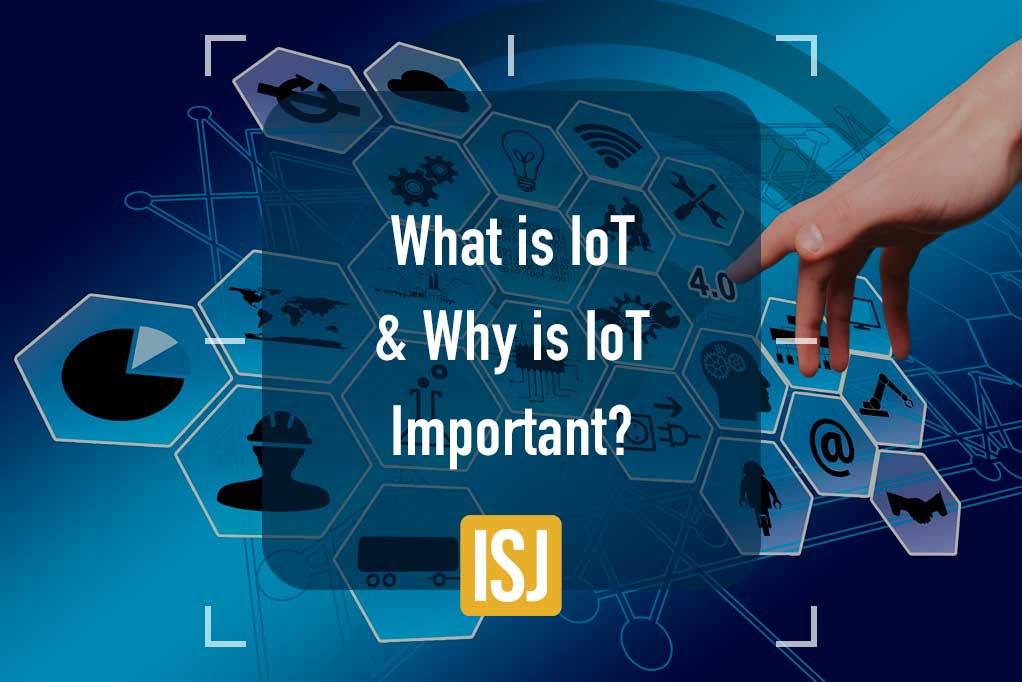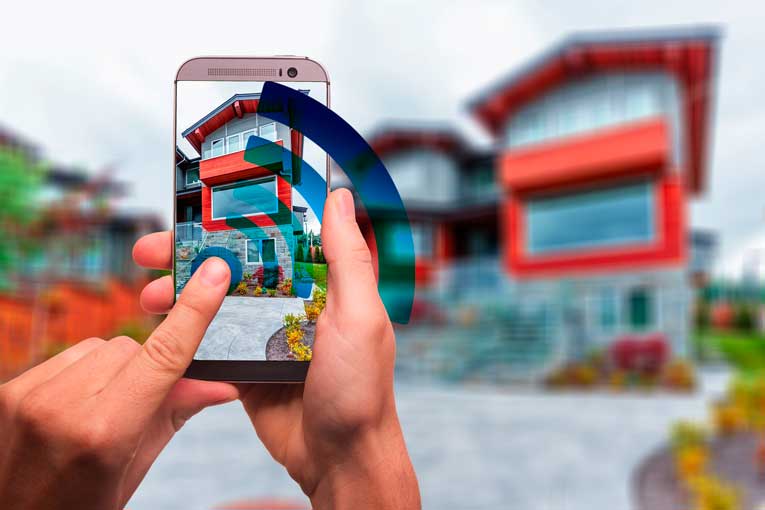What is IoT & Why IoT is Important


Simon Burge
Share this content
So you’re curious about the Internet of Things (IoT), what it is and why IoT is important in today’s modern society.
Although it may be a seemingly recent term, it’s actually been with us for a number of decades now.
Only with the advent of connected technology has the subject of IoT come to the fore.
In this article, we remove the mystery surrounding the IoT, how it works and how it will shape our futures.
Article Chapters
ToggleWhat is the Internet of Things (IoT)?

The Internet of Things (IoT) refers to a network of interconnected devices, machines, objects, and even living beings that possess unique identifiers (UIDs).
All have the capability to exchange data over a network without the need for direct human or computer interaction.
These devices can range from computing devices to mechanical systems, and enable seamless communication and data transfer, leading to increased automation and efficiency in various domains.
By leveraging IoT technology, the world becomes more interconnected, allowing for enhanced monitoring, control, and communication between diverse entities, ultimately shaping a more interconnected and intelligent ecosystem.
In the Internet of Things (IoT), a “thing” can refer to various entities, such as a person wearing a smartwatch, livestock fitted with RFID transponders, or vehicles such as cars, trucks or motorbikes with tracking devices.
Essentially, any object, whether natural or man-made, can be assigned an Internet Protocol (IP) address and possess the capability to transmit data over a network.
This interconnectedness enables seamless communication and data exchange, enhancing monitoring, control, and functionality across a wide range of applications.
The IoT empowers objects and beings with the ability to contribute to and benefit from the vast network of connected devices, creating a more intelligent and interconnected world.
History of IoT

In 1999, the co-founder of the Auto-ID Center at MIT, Kevin Ashton introduced the concept of the Internet of Things (IoT) during a presentation to Procter & Gamble (P&G).
His intention was to highlight the potential of radio frequency identification (RFID) technology to P&G’s senior management.
Ashton cleverly named his presentation “Internet of Things” to align with the trending concept of the internet during that time.
Additionally, MIT professor Neil Gershenfeld’s book, titled “When Things Start to Think,” published in the same year, provided a clear vision of the direction in which the IoT was heading, even though it didn’t explicitly use the term.
These early contributions laid the foundation for the development and recognition of the IoT as a transformative concept.
While Kevin Ashton is credited with popularising the term “Internet of Things” in his presentation in 1999, the concept of connected devices has been present since the 1970s.
Back then, it was referred to as the “embedded internet” or “pervasive computing.”
These early ideas laid the foundation for the interconnected world we see today, where devices are seamlessly integrated into our daily lives, sharing data and enabling new possibilities.
Ashton’s contribution brought attention to this evolving concept and helped shape the narrative around the Internet of Things.
Today, the Internet of Things (IoT) has emerged through the convergence of wireless technologies, microelectromechanical systems (MEMS), microservices, and the internet.
This convergence has played a crucial role in breaking down the barriers between operational technology (OT) and information technology (IT).
As a result, unstructured data generated by machines can now be analyzed to extract valuable insights and drive continuous improvements.
The integration of these technologies has paved the way for a more interconnected and data-driven ecosystem.
In the early 1980s, a notable example of an internet appliance was a Coke machine located at Carnegie Mellon University.
This machine was connected to the web, allowing programmers to remotely check its status.
They could easily determine if the machine was stocked with cold drinks, saving them a trip if they were not available.
This early instance showcased the potential of connecting everyday objects to the internet and accessing information remotely, foreshadowing the broader concept of the Internet of Things.
IoT emerged from the concept of machine-to-machine (M2M) communication, which involves the interconnection of devices through a network without human intervention.
M2M technology enables devices to connect to the cloud, enabling remote management and data collection.
It forms the foundation of IoT by facilitating the seamless exchange of information and enabling devices to operate intelligently and autonomously.
IoT represents the advancement of M2M technology, forming a vast network of intelligent devices that connect individuals, systems, and various applications to gather and exchange data.
M2M serves as the underlying connectivity framework that enables the seamless integration and communication between these devices, forming the foundation of IoT.
Through this interconnected ecosystem, IoT enables a multitude of innovative applications and services that enhance efficiency, automation, and data-driven insights.
The internet of things (IoT) builds upon the foundation of supervisory control and data acquisition (SCADA), which encompasses software applications for real-time data gathering and process control in remote locations.
SCADA systems consist of hardware and software components, with the hardware collecting data and transmitting it to a computer running SCADA software.
The software processes and presents the data in a timely manner.
As SCADA systems have evolved, they have paved the way for the development of early IoT systems, demonstrating the natural progression towards interconnected and intelligent systems.
How IoT Works
An IoT ecosystem comprises web-enabled smart devices equipped with embedded systems, including processors, sensors, and communication hardware.
These devices gather, transmit, and respond to data from their surroundings.
IoT devices share the sensor data they collect by connecting to an IoT gateway or edge device, where the data is either sent to the cloud for analysis or analyzed locally.
In some cases, these devices communicate with other interconnected devices and take actions based on the information exchanged.
While human interaction is not always necessary, people can still interact with the devices, such as configuring them, providing instructions, or accessing the data they generate.
The connectivity, networking, and communication protocols employed by web-enabled devices in IoT vary depending on the specific applications implemented.
Additionally, IoT can leverage artificial intelligence (AI) and machine learning to facilitate and enhance data collection processes, making them more efficient and adaptable.
Why IoT is Important
To explain the significance of the Internet of Things, it’s crucial to acknowledge the widespread acceptance and appreciation of technology by individuals, businesses and organisations.
The Internet of Things (IoT) has revolutionised both our personal and professional lives, empowering us to lead smarter lives and businesses to achieve enhanced control and efficiency.
Through the automation of homes and the integration of smart devices, IoT enables seamless management of daily tasks.
Moreover, IoT plays a pivotal role in the business landscape.
IoT empowers companies to streamline operations, leading to increased efficiency and cost savings.
By automating processes, businesses can reduce labour costs while enhancing productivity.
Additionally, IoT aids in minimising waste and optimising resources, contributing to more sustainable and environmentally friendly practices.
In terms of service delivery, IoT plays a crucial role in improving customer experiences.
Through real-time monitoring and data analysis, companies can gain valuable insights into customer transactions, enabling them to offer personalised and efficient services.
This transparency not only enhances customer satisfaction but also facilitates effective supply chain management, enabling better decision-making throughout the manufacturing and delivery processes.
Ultimately, IoT enables companies to achieve cost-effectiveness, improved operational performance, and enhanced customer satisfaction.
This is why devices that enable data collection and interaction with other products have been swiftly adopted, quickly gaining popularity.
IoT enables us to do basic tasks like program a coffee machine or dishwasher remotely using a phone whilst on a train home from work, or download useful data to enhance exercise performance through worn smart devices.
The Internet of Things (IoT) streamlines various tasks, reducing human effort and providing an abundance of insightful information.
By empowering individuals with data, IoT fosters a sense of control over our lives.
Furthermore, the rise in popularity of these technologies can be attributed to advancements in product prototyping.
Entrepreneurs with innovative IoT concepts can now seek out prototype manufacturing companies to bring their ideas to life within a reasonable budget.
However, the success of an IoT device hinges on the existence of a market or a problem in need of a solution.
The entrepreneur shares their vision, while the prototyping company handles the rest with a team of skilled engineers responsible for constructing the machine or product.
Personal Benefits of IoT

The Internet of Things (IoT) has revolutionised the way individuals interact with technology, providing a multitude of benefits that enhance everyday life.
By connecting various smart devices and enabling them to communicate and share information, IoT empowers individuals with convenience, efficiency, and unprecedented control over their environments.
From smart homes that automate daily tasks to wearable devices that monitor health and fitness, IoT seamlessly integrates into our lives, making them more comfortable, productive, and enjoyable.
With IoT, individuals can experience a new level of interconnectedness, enabling them to make informed decisions, save time and resources, and enhance their overall well-being.
Quality of Life
Smartphones have become an integral part of our daily lives, serving as versatile tools that enable us to accomplish a multitude of tasks, from communication to productivity.
However, the true power of smartphones lies in their ability to connect to the Internet of Things (IoT), expanding their functionality and enhancing the quality of our lives.
IoT devices facilitate seamless communication and interaction, allowing us to effortlessly access information, stay connected, and streamline various aspects of our routines.
Whether it’s receiving reminders for appointments or swiftly retrieving important documents, IoT enables us to save time and allocate it to more meaningful activities.
By leveraging IoT technology, we can enhance our productivity.
The automation and convenience offered by IoT devices free our minds from unnecessary burdens, enabling us to focus on more critical tasks and make the most of our abilities.
Moreover, IoT has extended its reach to the realm of wellness, introducing devices that prioritize our health and well-being.
From wearable fitness trackers to smart home devices that create a comfortable environment, IoT promotes a holistic approach to wellness and empowers individuals to prioritize self-care.
Automation
Automation facilitated by IoT offers numerous advantages that significantly impact our everyday lives.
Firstly, it simplifies and streamlines routine tasks, freeing up time and mental energy for more meaningful activities.
IoT-enabled devices can automate household chores, such as controlling lighting, temperature, and appliances, making our living spaces more comfortable and efficient.
Secondly, automation enhances convenience by enabling remote access and control of various systems through smartphones or voice assistants.
This means we can adjust settings, monitor security, and manage our homes even when we’re away.
Additionally, IoT automation promotes energy efficiency and cost savings by optimizing resource usage based on real-time data.
Smart thermostats, for example, can automatically adjust temperature settings to minimise energy consumption.
Lastly, automation enhances safety by integrating intelligent sensors and alarms that detect potential hazards, such as smoke, leaks, or intrusions, and provide timely alerts for prompt action.
In summary, IoT-driven automation enhances our everyday lives by offering convenience, efficiency, cost savings, and improved safety and security.
Data Driven Decisions
Data-driven decisions facilitated by IoT have numerous advantages that positively impact our everyday lives.
Firstly, by leveraging the vast amount of data collected through IoT devices, individuals can gain valuable insights into their behaviours, habits, and preferences.
This knowledge enables personalised experiences and tailored recommendations, whether it’s receiving targeted product suggestions or accessing customised health and wellness advice.
Additionally, data-driven decisions foster greater efficiency and productivity.
IoT-powered devices and systems provide real-time information, allowing individuals to optimise their energy usage, streamline workflows, and make informed choices that save time and resources.
Moreover, data-driven decisions enhance safety and security by enabling early detection of anomalies or potential risks, such as detecting unusual patterns in home security systems or identifying irregularities in personal health monitoring.
Ultimately, IoT-driven data analysis empowers individuals to make more informed, efficient, and personalised decisions, enhancing various aspects of their daily lives.
Real-time Monitoring
Real-time monitoring offers numerous advantages that positively impact our everyday lives.
One significant advantage is the ability to proactively manage and optimise various systems and processes.
For example, real-time monitoring of energy consumption in smart homes allows residents to make informed decisions about energy usage, leading to cost savings and reduced environmental impact.
In industry, real-time monitoring of production lines and equipment performance enables timely identification of issues, minimising downtime and maximizing productivity.
Additionally, real-time monitoring in healthcare facilitates remote patient monitoring, allowing healthcare providers to intervene promptly in case of emergencies or changes in health conditions.
Real-time monitoring also enhances safety, as sensors can detect and alert us to potential risks such as gas leaks or water leaks, preventing accidents and damage.
Overall, real-time monitoring through IoT empowers us with valuable insights and timely actions, making our lives safer, more efficient, and better informed.
Business Benefits of IoT

IoT provides numerous advantages to organisations, including both industry-specific benefits and those applicable across various industries.
Among them, the many common benefits include:
Monitoring Business Processes
IoT revolutionises the monitoring of business processes by providing real-time visibility and control over various operations.
With IoT-enabled sensors, devices, and data analytics, organisations can gather valuable insights into their processes, assets, and resources.
This enables them to monitor key performance indicators, identify inefficiencies or bottlenecks, and proactively address issues before they escalate.
IoT allows for continuous monitoring of critical parameters such as production output, equipment performance, energy consumption, and supply chain logistics.
By leveraging IoT for monitoring business processes, companies can optimise operations, improve efficiency, and ensure smooth and reliable workflows, ultimately leading to enhanced productivity and profitability.
Enhance Customer Experience (CX)
IoT plays a crucial role in enhancing customer experiences by enabling organisations to deliver personalised, convenient, and seamless interactions.
IoT devices and applications allow businesses to gather valuable data about customer preferences, behaviour, and usage patterns.
This data can be leveraged to create tailored products, services, and experiences that cater to individual needs and preferences.
For example, smart home devices can automatically adjust temperature, lighting, and other settings based on individual preferences, providing a personalized and comfortable environment.
IoT also enables proactive and predictive customer service by alerting businesses to potential issues or needs before customers even realise them, leading to faster and more efficient problem resolution.
By leveraging IoT technologies, organisations can create delightful and personalised experiences that drive customer loyalty, satisfaction, and ultimately, business growth.
Time & Cost Savings
IoT technologies offer significant time and cost savings for businesses across various industries.
By automating and streamlining processes through interconnected devices, IoT reduces manual intervention, human error, and repetitive tasks.
For instance, in manufacturing, IoT-enabled sensors and monitoring systems can optimise production processes, minimise downtime, and prevent equipment failures, resulting in increased operational efficiency and reduced maintenance costs.
Additionally, IoT enables real-time tracking and monitoring of assets, inventory, and supply chain logistics, allowing businesses to optimise inventory levels, improve order accuracy, and reduce wastage.
The ability to collect and analyse data from IoT devices also facilitates predictive maintenance, enabling proactive repairs and minimising unplanned downtime.
Ultimately, IoT helps businesses optimise resource utilisation, streamline operations, and make informed decisions, leading to substantial time and cost savings.
Increase Productivity
IoT plays a crucial role in enhancing employee productivity by streamlining workflows, automating tasks, and providing real-time access to information.
IoT devices and sensors can be integrated into the workplace environment, enabling seamless communication, collaboration, and information sharing among employees.
For example, smart office solutions can automate routine administrative tasks like scheduling meetings, managing calendars, and controlling room environments, freeing up employees’ time to focus on more critical tasks.
IoT-enabled wearable devices can track employee activities, monitor health and well-being, and provide personalised insights to improve productivity and well-being.
Moreover, IoT facilitates remote work and mobility, allowing employees to access company resources and collaborate from anywhere, leading to increased flexibility and efficiency.
By leveraging IoT technologies, businesses can empower their employees with tools and systems that optimise productivity, streamline workflows, and foster a more connected and efficient work environment.
Adapt Business Models
IoT plays a pivotal role in integrating and adapting business models by enabling seamless connectivity and data exchange between various systems and processes.
IoT devices and sensors can be deployed across different aspects of a business, such as supply chain management, inventory control, and customer service, allowing for real-time data collection and analysis.
This data can be leveraged to gain valuable insights into customer behavior, market trends, and operational efficiency, enabling businesses to make informed decisions and adapt their strategies accordingly.
Additionally, IoT enables the integration of physical and digital systems, creating new opportunities for innovative products and services.
For example, IoT can enable the transformation of traditional products into smart, connected devices, opening up new revenue streams and business models.
By embracing IoT, businesses can achieve greater agility, responsiveness, and competitiveness in today’s rapidly evolving digital landscape.
Improve Business Decisions
IoT empowers businesses to make better decisions by providing them with real-time and actionable data.
With IoT devices and sensors deployed throughout various processes, businesses can collect and analyse vast amounts of data, allowing for a comprehensive understanding of their operations.
This data-driven approach enables businesses to gain insights into customer preferences, market trends, and operational performance, facilitating informed decision-making.
By harnessing the power of IoT analytics, businesses can identify patterns, detect anomalies, and predict future outcomes, enabling them to optimise their strategies, mitigate risks, and seize opportunities.
Ultimately, IoT enhances the decision-making process by providing accurate and timely information, empowering businesses to stay ahead in a competitive landscape.
Increased Revenue
IoT has the potential to generate more revenue for businesses through various avenues.
By leveraging IoT technologies, businesses can enhance their product offerings and create new revenue streams.
For example, IoT-enabled devices can provide value-added services and personalised experiences to customers, leading to increased customer satisfaction and loyalty.
Additionally, IoT data can be utilised for targeted marketing and product development, enabling businesses to tailor their offerings to meet specific customer needs and preferences.
Moreover, IoT enables businesses to optimize their operations and improve efficiency, reducing costs and maximising profits.
By streamlining processes, automating tasks, and minimising downtime, businesses can increase productivity and revenue.
Furthermore, IoT facilitates the adoption of predictive maintenance, allowing businesses to proactively address equipment issues and minimise costly downtime.
Overall, IoT presents opportunities for businesses to innovate, create new revenue streams, and drive growth in a digitally connected world.
Pros & Cons of IoT
The Internet of Things (IoT) offers numerous advantages that have the potential to transform various aspects of our lives.
Convenience & Efficiency
IoT offers convenience and efficiency by automating tasks, providing remote control capabilities, and streamlining daily activities.
Real-Time Data & Decision-Making
IoT enables the collection of real-time data, allowing for better decision-making based on accurate and timely information.
Connectivity & Integration
IoT promotes connectivity and integration between devices, systems, and services, fostering collaboration, innovation, and the development of new business models.
Cost Savings
IoT can lead to cost savings through optimized resource utilization, energy efficiency, and improved maintenance practices.
Safety & Wellbeing
IoT enhances safety and well-being through remote monitoring, early detection of risks, and prompt response to emergencies.
Whilst the list of advantages of IoT are seemingly attractive, there are numerous pitfalls that need to be taken into consideration.
Security & Privacy
IoT introduces new security and privacy challenges, as interconnected devices can become targets for cyberattacks, data breaches, and unauthorized access.
Interoperability & Compatibility
The lack of standardised protocols and interoperability among IoT devices can hinder seamless integration and communication between different systems, limiting their effectiveness and creating compatibility issues.
Complexity & Technical Issues
Deploying and managing IoT systems can be complex, requiring expertise in areas such as data analytics, network infrastructure, device management, and cybersecurity.
Technical challenges, including scalability and reliability issues, can also arise.
Data Overload & Quality
With the abundance of data generated by IoT devices, organisations face the challenge of processing, analysing, and extracting meaningful insights from massive data sets.
Ensuring data quality and accuracy is crucial to avoid making erroneous decisions based on flawed or incomplete information.
Ethical & Legal Concerns
IoT raises ethical and legal considerations regarding data ownership, consent, and privacy.
The collection, use, and sharing of personal data without proper consent and transparency can lead to ethical dilemmas and legal implications.
IoT Standards
Several emerging IoT standards are shaping the landscape of connected devices and technologies.
These standards include:
6LoWPAN
6LoWPAN (IPv6 over Low Power Wireless Personal Area Networks) is an open standard established by the Internet Engineering Task Force (IETF) that facilitates the communication of low-power radios with the internet.
This standard allows various low-power wireless technologies, such as 802.15.4, Bluetooth Low Energy (BLE), and Z-Wave (used in home automation), to connect and transmit data to the internet.
MQTT
MQTT (Message Queuing Telemetry Transport) is a lightweight messaging protocol designed for efficient communication between devices with limited bandwidth and power resources.
It’s widely used in IoT applications for its simplicity and low overhead.
CoAP
CoAP (Constrained Application Protocol) is a specialised protocol designed for resource-constrained devices in low-power and lossy networks.
It enables efficient communication and data transfer between IoT devices and the web.
Zigbee
Zigbee is a wireless communication standard specifically designed for low-power, short-range, and low-data-rate applications.
It’s commonly used in home automation and building control systems.
Z-Wave
Z-Wave is another wireless communication protocol designed for home automation applications.
It operates in the sub-GHz frequency range and offers reliable and secure communication between IoT devices.
LoRaWAN
LoRaWAN (Long Range Wide Area Network) is a low-power wide-area network protocol that enables long-range communication for IoT devices.
It’s suitable for applications that require wide-area coverage, such as smart cities and agricultural monitoring.
LiteOS
LiteOS is a Unix-like operating system specifically designed for wireless sensor networks.
It offers comprehensive support for a wide range of applications, including smartphones, wearables, intelligent manufacturing, smart homes, and the Internet of Vehicles (IoV).
Beyond its role as an operating system, LiteOS also serves as a versatile development platform for creating innovative smart devices.
With its flexibility and compatibility, LiteOS empowers developers to harness the potential of wireless sensor networks and build cutting-edge solutions across various domains.
OneM2M
OneM2M is a globally recognised machine-to-machine service layer that facilitates seamless connectivity among devices.
By embedding OneM2M in both software and hardware, devices can establish communication and interoperability.
The primary objective of OneM2M is to establish reusable standards, enabling effective communication between IoT applications across various industry verticals.
As a leading global standardisation body, OneM2M plays a crucial role in driving the widespread adoption of IoT and ensuring the interoperability and compatibility of diverse IoT ecosystems.
Data Distribution Service (DDS)
Data Distribution Service (DDS) is an IoT standard for facilitating real-time, scalable, and high-performance machine-to-machine (M2M) communication.
Developed by the Object Management Group (OMG), DDS provides a robust framework for efficient data distribution across distributed systems.
With its focus on reliability, scalability, and low-latency communication, DDS is well-suited for applications requiring real-time data exchange, such as industrial automation, smart grids, healthcare systems, and transportation networks.
By adhering to the DDS standard, organisations can ensure interoperability and seamless integration of diverse IoT devices and systems, enabling efficient and reliable communication in dynamic environments.
AMQP
The Advanced Message Queuing Protocol (AMQP) is an open-source published standard that facilitates asynchronous messaging across different systems.
With AMQP, organisations and applications can securely and interoperably exchange messages.
This protocol supports encrypted messaging, ensuring data privacy and security.
AMQP is widely used for client-server messaging and plays a crucial role in IoT device management, enabling efficient communication and coordination between IoT devices and the systems they interact with.
By adhering to the AMQP standard, organisations can achieve seamless integration and reliable messaging across diverse applications and platforms.
IoT Frameworks
There are various IoT frameworks available, including:
Amazon Web Services (AWS)
Amazon Web Services (AWS) IoT is an IoT cloud computing platform developed by Amazon.
It’s specifically designed to facilitate seamless connectivity and secure communication between smart devices, the AWS cloud, and other interconnected devices.
The AWS IoT framework offers a robust and scalable solution for managing and analysing IoT data, enabling businesses to leverage the power of the cloud for their IoT applications.
Arm Mbed IoT
Arm Mbed IoT is a platform that enables the development of IoT applications using Arm microcontrollers.
Its primary objective is to offer a secure, connected, and scalable environment for IoT devices by incorporating Mbed tools and services.
Microsoft Azure IoT
Azure IoT, developed by Microsoft, is a comprehensive platform comprising a range of services that empower users to engage with their IoT devices and access data from them.
Additionally, the platform enables users to perform diverse operations on the data, including multidimensional analysis, transformation, and aggregation.
It also facilitates the visualisation of these operations in a manner that aligns with business requirements.
Google Brillo & Weave
Brillo and Weave, developed by Google, is a versatile platform designed to accelerate the creation of IoT applications.
The platform comprises two primary components:
Brillo, an operating system based on Android that facilitates the development of low-power embedded devices.
Weave, an IoT-focused communication protocol that acts as the language for seamless device-to-cloud communication.
Together, Brillo and Weave provide a robust foundation for building and deploying IoT solutions with ease.
Calvin
Calvin, an open-source IoT platform developed by Ericsson, is specifically designed to facilitate the creation and management of distributed applications that foster seamless communication between devices.
This comprehensive platform encompasses a development framework tailored for application developers, along with a runtime environment that efficiently handles the execution of the applications.
With Calvin, users can effortlessly build and manage IoT solutions that enable effective device-to-device interaction within their ecosystem.
IoT Security Concerns
IoT security and privacy concerns have become increasingly prominent due to the widespread adoption of interconnected devices.
The unique nature of IoT networks, with their vast number of connected devices and diverse range of applications, presents significant challenges for ensuring robust security measures.
Vulnerabilities in IoT devices can lead to unauthorised access, data breaches, and even compromise of critical infrastructure.
Additionally, the collection and transmission of massive amounts of personal and sensitive data raise concerns about privacy and data protection.
Issues such as data ownership, consent, and secure data handling practices have become focal points in the ongoing discussions about IoT security and privacy.
Addressing these concerns requires a comprehensive approach that includes robust encryption, authentication mechanisms, regular software updates, and adherence to privacy regulations to ensure the confidentiality, integrity, and privacy of IoT systems and the data they handle.
Conclusion
The Internet of Things (IoT) is undeniably here to stay.
Its rapid growth and integration into various aspects of our lives demonstrate its potential to transform industries and shape the future.
While there are valid concerns about security, privacy, and other challenges associated with interconnected technology, the benefits and opportunities it offers cannot be overlooked.
The ability to connect and automate devices, gather and analyse vast amounts of data, and enable real-time decision-making brings immense value to businesses and individuals alike.
As technology continues to advance, it’s crucial to address the challenges and ensure proper safeguards are in place.
With responsible implementation and a focus on addressing the associated risks, IoT has the potential to revolutionise industries, enhance efficiency, improve quality of life, and unlock new opportunities in the interconnected world of the future.


